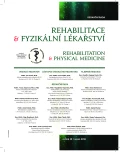Possible Influence of Increased Frequency by Manual Treatment of Ligamentum Pubovesicale
Authors:
L. Štolc
Authors‘ workplace:
Nestátní zdravotnické zařízení Rehabilitace ŠL, Libina
Published in:
Rehabil. fyz. Lék., 25, 2018, No. 3, pp. 91-98.
Category:
Original Papers
Overview
This pilot study attempts to objectify the dependence of increased tension of pubovesical ligament on the frequency of micturition. In the first phase the author compared the micturition frequency during the night in a group of 60 probands with increased tension of pubovesical ligament as compared with a group of 60 probands without with increased tension of the ligamentum. In the second phase we followed the dependence of micturition on manual treatment of pubovesical ligament. The probands with increased tension of the ligamentum were divided into three groups. The group with performed manual treatment of pubovesical ligament was compared with that who underwent manual treatment in the segments of locomotion apparatus, which is associated with a neurophysiological chain with urinary bladder and also compared with a group without treatment. The conclusions refer to the significant influence of increased tension of the ligament on a higher frequency of micturition of the probands during the day (p<0.05) and the effect of ligament treatment on the decrease of micturition at night as well (p<0.05).
Keywords:
pubovesical ligament, frequency of micturition, urinary bladder
Sources
1. BARRAL, J. P., MERCIER, P.: Viscerální terapie. Kroměříž, Zapletal Stanislav, 2006, s. 191-207.
2. ČIHÁK, R.: Anatomie 2. Praha, Grada, 2002, s. 297-311.
3. DE KONING, A. J.: Visceral manipulation: The pelvis. Praha, The Barral Institute, kurz 16. – 19. 9. 2010
4. DELANCEY J. O. L.: Pubovesical ligament: A separate structure from the urethral supports (“Pubo-Urethral Ligaments”). Neurourology Urodynamics, 1989; 8, s. 53-61.
5. DÍTĚ, Z.: Infekce močových cest z pohledu urologa 2010, http://www.solen.cz/pdfs/ped/2010/02/05.pdf.
6. DRLÍK, P.: Nykturie-současné možnosti léčby. Praha, http://www.solen.cz/pdfs/ uro/2010/04/02.pdf.
7. DYLEVSKÝ, I.: Obecná kineziologie. Praha, Grada, 2007, s. 29-41.
8. GRAY, H.: Anatomy of the human body. 2000, http://www.bartleby.com/107/
9. HAMM, B., FORSTNER, R.: MRI and CT of the female pelvis. Berlin, Springer-Verlag, 2007, 387 s.
10. HEBGEN, E. U.: Visceral manipulation in Osteopathy. New York, Thieme, 2011, 224 s.
11. HERSCHORN, S.: Female pelvic floor anatomy: The Pelvic Floor, Supporting Structures and Pelvic Organs, 2004, https://www.ncbi.nlm.nih.gov/pmc/articles/PMC1472875/
12. HUDÁK, R. a kol.: Memorix anatomie. Praha, Triton, 2013, 605 s.
13. JUNGINGER, B. a kol.: Effect of abdominal and pelvic floor tasks on muscle aktivity, abdominal pressure and bladder neck. In Internacional Urogynecology Journal, Berlin, Springer-Verlag, roč. 21, 2010, č. 1, s. 69-77.
14. KAWACIUK, I.: Urologie. Praha, Galén, 2009, 531 s.
15. KLADENSKÝ, J.: Infekce dolních močových cest u žen - možnosti diferenciovaného přístupu léčby a prevence. 2010, http://www.solen.cz/pdfs/uro/2010/05/03.pdf.
16. KLEČKA, J. a kol.: Vybrané názvosloví urodynamiky a mikčních symptomů dolních cest močových. 2012, http://www.solen.cz/pdfs/uro/2012/02/06.pdf.
17. PAOLETTI, S.: Fascie: Anatomie, dysfunkce, léčení. Olomouc, Poznání, 2009, s. 263-276.
18. PETROS, P. E. P.: The female pelvic floor. Berlin, Springer – Verlag, 2010, 331s.
19. SKALKA, P.: Možnosti léčebné rehabilitace v léčbě močové inkontinence. 2002, http:// www.urologiepropraxi.cz/pdfs/uro/2002/03/02.pdf.
20. STOKER, J. a kol.: Imaging pelvic floor disorders. Berlin, Springer – Verlag, 2010, 288 s.
21. ŠTOLC, L., HAVLOVÁ, J.: Vliv zvýšeného napětí ligamenta pubovesicale na zřetězení fumkcí. Fyzioterapia - vzdelávanie a prax, medzinárodná vedecká konferencia, Bratislava. Slovenská zdravotnícka univerzita, 2017, s. 207-219.
22. THOMPSON, A. J. a kol.: Assessment of pelvic floor movement using transabdominal and transperineal ultrasoud. Internacional Urogynecology Journal, Berlin, Springer-Verlag, roč. 16, 2005, č. 4, s. 285-292 .
Labels
Physiotherapist, university degree Rehabilitation Sports medicineArticle was published in
Rehabilitation and Physical Medicine

2018 Issue 3
Most read in this issue
- Stroke: Recommendations for Patients and Their Families
- Activation of Breathing in Upper Crossed Syndrome
- Efficiency of Robot-assisted Therapy through the Device Armeo Spring in Patients after Stroke in Acute Phase of Early Rehabilitation
- Possible Influence of Increased Frequency by Manual Treatment of Ligamentum Pubovesicale
